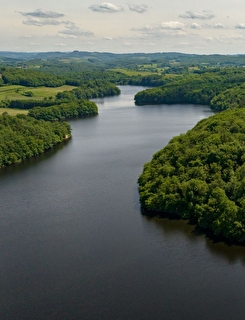
Circuit de randonnée : Boucle de la vallée de la cure
This loop runs along the right bank of the Cure and passes by the Rocher de la Pérouse, which offers a wide panoramic view of the Morvan.
The Morvan heated Paris from 1550 to 1850 thanks to the "flottage buches à perdues" from the Morvan and the "flottage en train de bois" from Clamecy. The loggers cut the selected trees, cut out the mouldings (logs measuring 1.14 m and about 15 cm in diameter) and stacked them before being transported by the famous Morvan cart to the "floating ports". The two main "routes" were the Yonne and the Cure, but their tributaries were also floated depending on the forests exploited.
The view from the top of the Rocher de la Pérouse is breathtaking, allowing you to appreciate the wild beauty of the Cure ravine and part of the Dun-Les-Places commune. It was here that the first parachute drop of British weapons took place on 23 November 1942.





